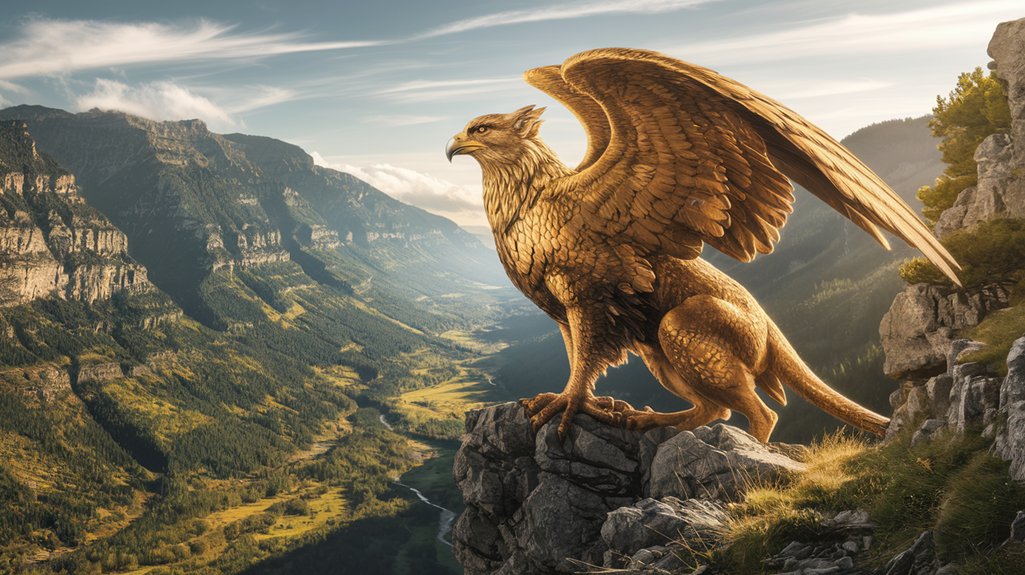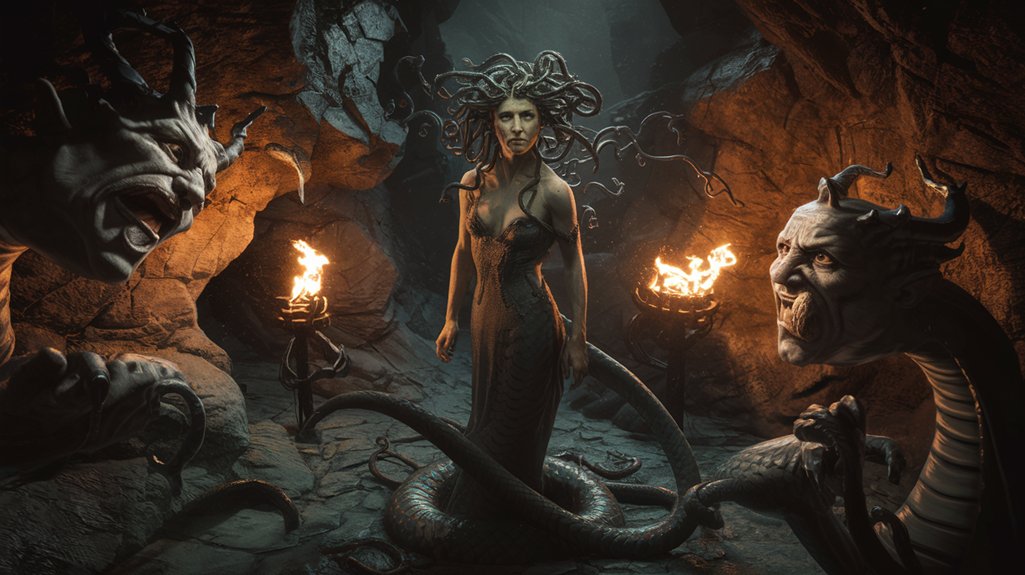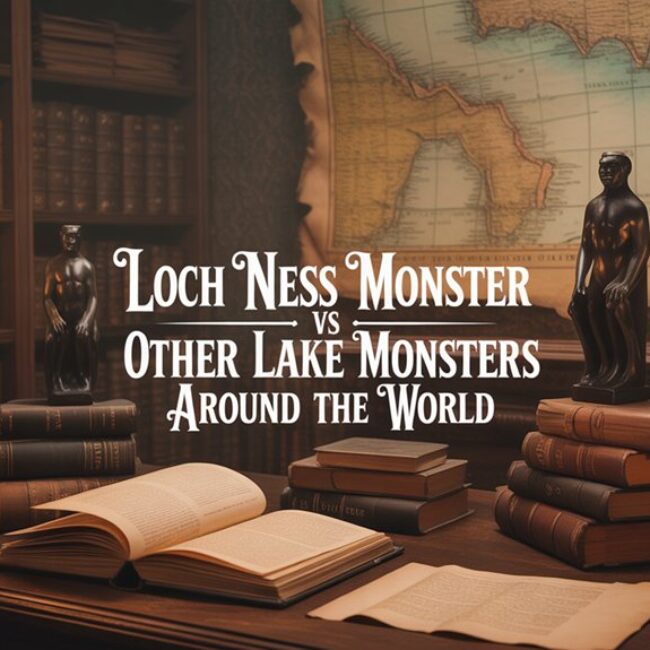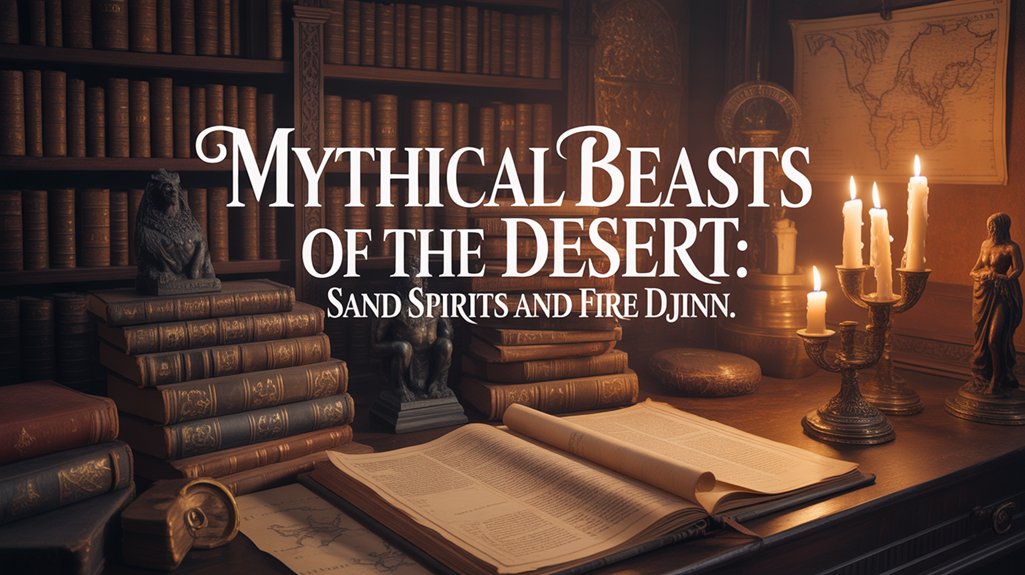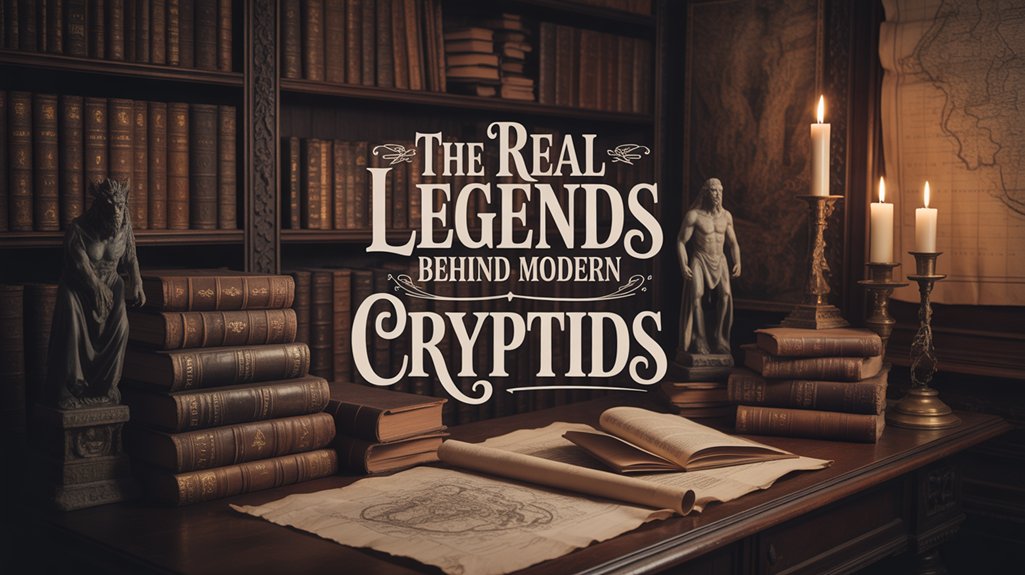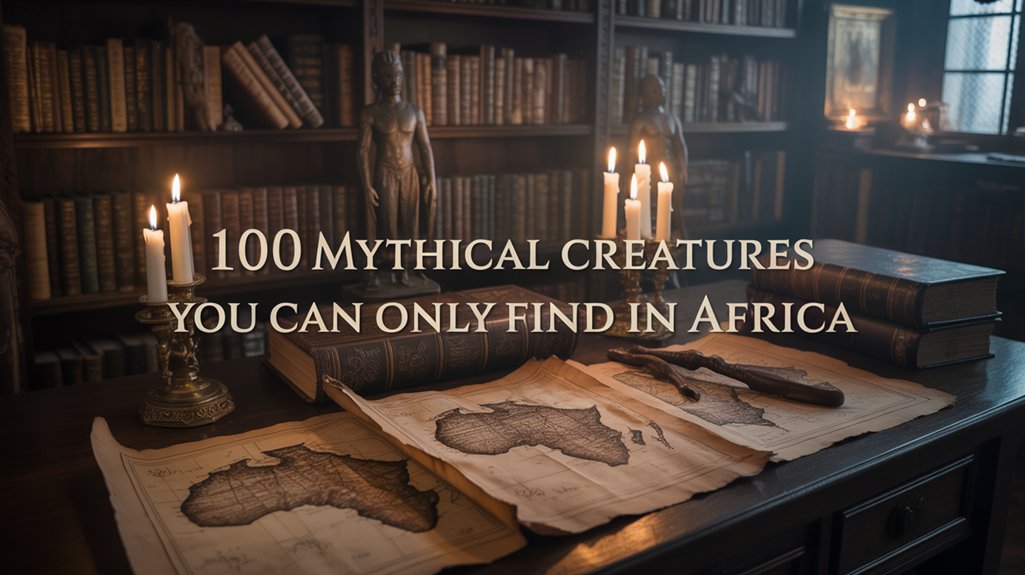
You’ll encounter salamanders thriving within flames as fire’s embodiment, undines commanding rivers and tides as water’s sentient expression, sylphs orchestrating invisible atmospheric currents as air’s ethereal guardians, and gnomes dwelling in subterranean chambers as earth’s ancient custodians—each elemental spirit emerging from frameworks like Empedocles’ fifth-century Greek cosmology and Paracelsus’s alchemical manuscripts, representing humanity’s primordial attempt to assign consciousness to natural forces that simultaneously sustain and alter existence, a taxonomy that persists from medieval bestiaries through contemporary fantasy literature’s chimeric constructs, revealing deeper archetypal patterns beneath surface mythology.
Table of Contents
ToggleKey Takeaways
- Salamanders are fire elementals depicted as serpentine creatures thriving within flames, symbolizing transformation, resilience, and rebirth.
- Undines are water spirits inhabiting rivers and lakes, known for their beauty, healing abilities, and power to manipulate currents.
- Gnomes are earth guardians dwelling underground, acting as ancient craftsmen who understand stone’s language and protect mineral deposits.
- Sylphs are air elementals commanding winds and clouds, serving as ethereal beings that whisper prophetic visions and embody insight.
- The Phoenix represents fire’s regenerative power through cycles of self-immolation and rebirth, appearing across Greek, Chinese, and modern mythology.
Fire, Water, Air, Earth Unite

Since humanity first gazed upon the primal forces shaping existence, mythical creatures have emerged as embodiments of the four classical elements—fire, water, air, and earth—each serving as a bridge between the material and metaphysical spheres.
You’ll discover Salamanders thriving within flames, their lizard-like forms dancing through conflagrations, embodying fire’s transformative resilience. Undines emerge from primordial waters, enchanting spirits whose very essence flows with healing currents and fluid grace.
Within flame and flood, these elemental guardians embody their domains—Salamanders blazing with transformative fire, Undines flowing with healing waters.
Above, Sylphs drift through atmospheric realms, eldritch beings who command weather patterns while inspiring mortal creativity through whispered zephyrs. Below, Gnomes burrow deep within terrestrial foundations, wise guardians whose chimeric craftsmanship reveals earth’s hidden treasures and nurturing stability.
This elemental harmony transcends mere categorization—it represents mythical unity, an ancient understanding that you’re witnessing whenever these beings manifest their spheres’ quintessential properties.
Each creature doesn’t simply inhabit its element; it becomes the element itself, offering you liberation from mundane perception into liminal spaces where matter and spirit converge. These elemental beings draw exclusively from real-world legends across cultures, reflecting humanity’s timeless attempt to personify nature’s fundamental forces.
##
You stand at the threshold where primordial forces manifest through chimeric forms, each elemental domain birthing its own distinct guardians and spirits throughout millennia of human consciousness.
The salamander’s eldritch flame-essence, the undine’s fluid grace, the sylph’s ethereal whisper, and the gnome’s terrestrial sovereignty—these beings aren’t mere fantasy but rather crystallizations of ancient wisdom, codified across Paracelsian texts of the 16th century and echoed through earlier alchemical traditions.
Within their archetypal forms lies humanity’s attempt to comprehend and personify the raw, untamed powers that shape existence itself.
The pre-Christian Norse religion similarly personified natural forces through its pantheon of gods and goddesses, each embodying aspects of the elemental world that Vikings perceived as enchantingly intertwined with both nature and culture.
Fire Element Mythical Beings
While scholars trace elemental taxonomy back to Presocratic philosophy—Empedocles’ fifth century BCE tetrad of earth, air, fire, and water—the creatures embodying these primal forces emerged from far older, more visceral traditions.
You’ll find salamander symbolism woven throughout medieval bestiaries, where these eldritch beings appear as serpentine forms wreathed in perpetual flame, their scales blazing crimson and orange against parchment.
Fire folklore positions them as altering agents, spirits dwelling within conflagrations themselves. They don’t merely resist incineration—they thrive within it. Forest fires birth them, unharmed.
Medieval alchemists recognized their chimeric nature: simultaneously corporeal and elemental, bridging material reality and primordial force. Here lives rebirth incarnate, resilience forged in white heat, freedom from destruction’s finality.
Water Creatures and Legends
From flame’s consuming embrace, myth draws us toward water’s opposite domain—not as negation but as complementary force, equally primordial, equally animate with supernatural presence.
You’ll encounter Undine legends throughout Germanic traditions, where these eldritch feminine spirits inhabit rivers, lakes, springs—territorial, beautiful, possessed of healing craft. They manipulate currents, become human through love’s alchemy. Betrayal destroys them.
Water guardians proliferate globally: Japan’s Ryujin, dragon deity commanding tides and marine creatures, embodies oceanic sovereignty. These beings aren’t mere decoration. They’re threshold entities maintaining balance between terrestrial existence and aqueous mystery.
Water dragons emerge across cultures as chimeric protectors, their serpentine forms expressing change, emotional depth, the life-sustaining power you’ve always recognized in water itself. Freedom demands acknowledging these ancient testimonies.
Earth-Dwelling Magical Entities
As water’s depths yield to solid ground, mythology roots itself in earth’s enduring substance—stone, soil, mineral darkness where gnomes establish their primordial dominion.
These earth guardians, rendered through gnome folklore as diminutive humanoid forms bearing weathered features of ancient craftsmen, maintain sovereignty over subterranean territories—caves threading through mountain hearts, forests rooted in primeval loam, mines concealing eldritch treasures within geological strata.
You’ll discover them portrayed as repositories of terrestrial wisdom, beings who comprehend stone’s language and manipulate botanical growth through elemental affinity.
Their dual nature manifests clearly: benevolent mentors offering aid to those respecting earth’s boundaries, yet chimeric tricksters punishing transgression with mischievous retribution.
As wealth’s custodians, they oversee mineral deposits and buried riches, embodying humanity’s relationship with earth’s generative yet concealing power—that freedom found in understanding nature’s hidden architectures.
Air Spirits and Guardians
Where earth’s weight surrenders to atmosphere’s boundless reach, sylphs emerge as sovereign entities of wind and weather—those aerial guardians commanding clouds, tempests, and the invisible currents threading through sky’s vast architecture.
You’ll find Sylph symbolism woven through European alchemical manuscripts, depicting ethereal beings both winged and invisible, oscillating between corporeal beauty and eldritch formlessness.
These Air elementals don’t merely inhabit their domain—they orchestrate it, whispering prophetic visions into receptive minds, infiltrating dreams with chimeric wisdom.
When manifesting in human form, they’re tall, graceful apparitions embodying insight itself. Their powers transcend mere meteorological manipulation; they’re idea-brokers, dream-architects, messengers traversing the liminal spaces between thought and atmosphere.
Ancient traditions recognized them as essential intermediaries, proving humanity’s enduring belief in nature’s sentient intelligence—that liberation comes through acknowledging forces beyond material constraint.
Ancient Greek Elemental Philosophy
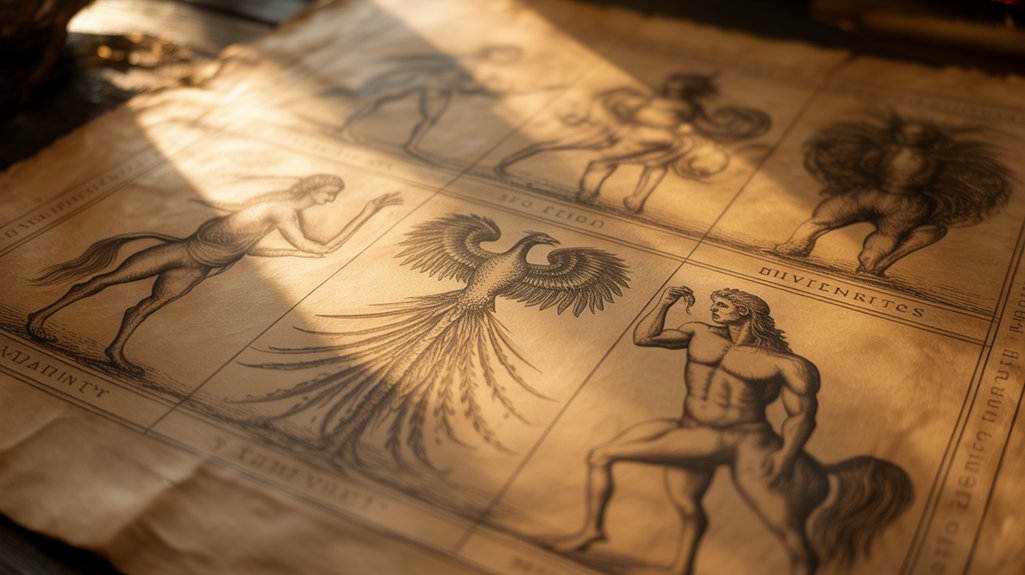
You must trace the genesis of elemental philosophy to fifth-century Greece, where Empedocles first articulated his groundbreaking cosmology—Earth, Water, Air, and Fire as the primordial constituents of all matter, bound and sundered by the opposing forces he named Love and Strife.
This Mediterranean worldview emerged not from mere speculation but from the eldritch intersection of religious mystery cults and pre-Socratic inquiry, where philosophers sought to explain alteration itself: how flesh becomes ash, how water assumes the chimeric forms of ice and vapor.
The ancient Greeks understood these elements as both physical substances and sacred principles, a duality that would echo through millennia of Western occult tradition.
Empedocles’ Fifth Century Theory
In the sun-scorched colonies of fifth-century BCE Sicily, Empedocles of Acragas—philosopher, mystic, and self-proclaimed divine being—forged a cosmological framework that would echo through millennia of Western thought.
Empedocles’ elements—earth, water, air, fire—formed the primordial alphabet from which all material existence spoke itself into being. These weren’t mere substances but living powers, governed by opposing forces he named Love and Strife, locked in eternal combat.
Love drew elements together, birthing chimeric forms and eldritch combinations; Strife tore them asunder, returning matter to its constituent roots. This perpetual cycle explained creation’s mysteries without divine caprice.
You’ll find his influence threading through Aristotle’s expanded elemental system, through medieval alchemy, into modern chemistry itself—a reflection of one man’s vision of cosmic order.
Ancient Greece and Mediterranean
Though Empedocles planted the seeds, the full garden of Greek elemental philosophy bloomed through successive generations of thinkers who refined, contested, and reimagined his fourfold schema into an intricate cosmological architecture. Plato crystallized Greek elemental symbolism through geometric precision, binding each element to its Platonic solid—earth’s steadfast cube, water’s flowing icosahedron, air’s ethereal octahedron, fire’s ascending tetrahedron. Aristotle transcended terrestrial boundaries entirely, introducing aether as the quintessence of celestial domains.
| Element | Platonic Form | Qualities |
|---|---|---|
| Earth | Cube | Cold, dry |
| Water | Icosahedron | Cold, wet |
| Air | Octahedron | Hot, wet |
| Fire | Tetrahedron | Hot, dry |
| Aether | Dodecahedron | Immutable |
Mediterranean mythological connections manifested through elemental spirits—eldritch beings embodying their respective territories, chimeric guardians dwelling in liminal spaces between matter and consciousness.
Religious and Philosophical Roots
Before temples rose to honor Zeus or Athena, before priests invoked Olympian names, Empedocles of Acragas stood upon Sicilian cliffs circa 495 BCE and proclaimed a radical cosmological vision—that all matter, from mortal flesh to mountain stone, emerged from the perpetual dance of four irreducible roots: earth (*gē*), water (*hydōr*), air (*aēr*), and fire (*pyr*).
You’ll find philosophical interpretations expanding through Plato’s *Timaeus*, where geometric solids became elemental symbolism incarnate. Aristotle added aether—the quintessence beyond terrestrial corruption.
Heraclitus saw fire’s altering hunger as cosmic law itself, eternal flux consuming and renewing. These weren’t mere abstract concepts; they were living forces, primal intelligences waiting.
When Paracelsus later named them—Gnomes, Undines, Sylphs, Salamanders—he crystallized what Greek mystics already sensed: elements possessed consciousness, chimeric spirits dwelling in reality’s eldritch foundations.
Chinese Four Symbols Framework

Deep within the cosmological architecture of ancient China, four celestial guardians emerged as cornerstones of directional power, their origins traced through archaeological evidence to approximately 5300 BC—making them among humanity’s oldest continuously venerated mythical constructs. The Four Symbols transcend mere mythology, operating as fundamental organizing principles within Taoist Philosophy where Elemental Balance manifests through cardinal alignments.
| Guardian | Direction/Element |
|---|---|
| Azure Dragon | East/Wood |
| Vermilion Bird | South/Fire |
| White Tiger | West/Metal |
| Black Tortoise | North/Water |
Each entity embodies specific virtues, seasons, emotions—interconnected threads within reality’s fabric. Taoist practitioners personified these guardians with human identities, altering eldritch concepts into protective deities. The Yellow Dragon completes this cosmological mandala, representing Earth at the Center, binding the system together. This framework’s Cultural Significance persists throughout the Sinosphere, demonstrating how ancient peoples encoded environmental observations into chimeric forms, creating navigation systems both spiritual and terrestrial.
Elemental Creature Symbolic Attributes
While the Chinese cosmology aligned mythical guardians with cardinal directions and seasonal cycles, Western alchemical traditions birthed a parallel taxonomy—one rooted not in geographical orientation but in the primal forces themselves.
Elemental creature symbolism emerged from medieval grimoires and Paracelsian treatises, codifying beings whose very essence embodied nature’s fundamental powers.
Each entity manifests distinct elemental beings characteristics:
- Salamanders: Eldritch fire-spirits draped in crimson and amber, thriving within conflagrations that would annihilate mortal flesh.
- Undines: Chimeric water-nymphs whose luminous voices lure travelers, commanding torrents and tides with gestures.
- Sylphs: Gossamer air-spirits governing tempests and zephyrs, existing between visibility and void.
- Gnomes: Ancient earth-guardians resembling wizened patriarchs, custodians of subterranean wealth and geological secrets.
These correspondences transcend mere classification. They represent humanity’s perpetual attempt to map the unmappable—to assign consciousness to forces that predated and will outlast our fragile civilizations, offering liberation through understanding nature’s hidden architecture.
Phoenix Rising From Ashes
You encounter the Phoenix first through flame—that primordial element which consumes and creates in equal measure, altering the ancient bird’s corporeal form into ash before catalyzing its miraculous resurrection.
Across the Mediterranean basin, from Hellenistic Egypt through Byzantine Constantinople, this aureate creature embodied fire’s paradoxical nature: destruction as the prerequisite for regeneration, death as the gateway to immortality.
The bird’s cyclical self-immolation, documented in texts spanning from Herodotus’s *Histories* (circa 440 BCE) to the Egyptian *Book of the Dead*, reveals how disparate civilizations recognized in its legend a profound truth about existence itself.
Symbolism of Fire Rebirth
Among the most potent archetypes woven through humanity’s collective mythos, the Phoenix stands as an eldritch symbol of metamorphosis’s sacred violence—a creature whose very essence demands annihilation before transcendence.
You’ll discover that phoenix symbolism operates through paradox: destruction becomes creation, death births energy, suffering forges strength. The life-altering flames consuming its ancient body don’t merely destroy—they transmute, purify, reconstitute. This isn’t gentle renewal; it’s radical obliteration followed by resurrection.
Ancient Greek sources placed its lifespan between five hundred and fourteen hundred years, each cycle ending in voluntary immolation. The ashes themselves become womb.
Chinese Fenghuang traditions emphasize grace emerging from tribulation. You’re witnessing humanity’s deepest truth encoded in feathers and fire: that freedom demands burning away what no longer serves, embracing the searing path toward becoming.
Cultural Mythology and Legends
Across civilizations separated by vast oceans and millennia, the Phoenix emerges—not as coincidence, but as archetype, a chimeric truth encoded in humanity’s deepest psychological strata.
You’ll find this flame-wreathed sentinel in Greek mythos, where it combusts every five hundred years in aromatic spice nests. Resurrection incarnate.
The Chinese Fenghuang mirrors this mythical symbolism through different cultural lenses—representing imperial harmony, feminine power, cosmic balance.
You witness the cultural significance in J.K. Rowling’s faithful Fawkes, whose tears heal wounds, whose loyalty transcends death itself.
These aren’t mere stories you’re encountering; they’re crystallized human yearning for transcendence, for rising unconquered from destruction’s embers.
The Phoenix teaches you what empires forget: that endings birth beginnings, that freedom requires periodic immolation of everything you’ve become.
Phoenix in Ancient Civilizations
Bennu—this heron-shaped herald of cosmic renewal—perched upon the primordial benben stone in Heliopolis, its presence witnessed by Egyptian priests who understood what their papyri whispered: death wasn’t terminus but threshold.
You’ll find Phoenix symbolism woven through civilizations that refused mortality’s finality. Ra’s solar vessel carried this creature across celestial waters, its cyclical immolation marking centuries, not mere decades.
Ancient rebirth manifested differently across borders: Greeks documented crimson-gold plumage igniting in aromatic flame, while Chinese Fenghuang embodied empress-bound virtue, its chimeric form transcending simple resurrection narratives.
Alchemists later recognized what ancients knew instinctively—transformation demanded fire’s purifying essence. These weren’t mere legends for those seeking liberation from linear existence.
They were cartographies of spiritual metamorphosis, eldritch maps suggesting you too might emerge luminous from devastation’s ashes.
Fantasy Literature and Gaming
When fantasy literature and gaming systems began crystallizing into their modern forms during the mid-twentieth century, they inherited millennia of elemental symbolism, altering ancient cosmologies into interactive worlds where dragons don’t simply represent fire—they embody it, channeling pyroclastic fury through scales described in Tolkien’s appendices as “wrought of living flame.
The earliest role-playing systems, particularly Dungeons & Dragons (1974), codified elemental beings into mechanistic frameworks: fire elementals with specific hit points and damage outputs, water elementals bound by movement restrictions, each creature stripped to its essential properties yet retaining that eldritch connection to primordial forces.
You’ll encounter elemental magic across contemporary media through:
- Avatar’s bending disciplines, where airbenders channel sky bison spirits
- Final Fantasy’s summoned Ifrit and Shiva, primordial beings bridging mythology and mechanics
- Pokémon’s Charizard and Vaporeon, chimeric constructs teaching children ancient elemental taxonomies
- Martin’s dragons in Westeros, sovereign beasts defying domestication
These fantasy creatures convert passive myth into participatory cosmology.
Jung’s Archetypal Elemental Psychology
While fantasy systematizers were quantifying elementals into combat statistics, Carl Gustav Jung (1875-1961) excavated psychological strata where earth, water, air, and fire functioned not as external phenomena but as interior architectures—structural blueprints of the psyche itself.
You’ll discover within his archetypal symbolism a cartography of consciousness: earth anchoring you through stability and material groundedness, water flowing through your emotional depths and intuitive currents, air circulating intellectual prowess and communicative exchange, fire igniting transformative passion and primordial will.
These elements manifest in your dreams as eldritch messengers from the collective unconscious. Ancient myths encoded what Jung decoded—chimeric beings weren’t merely imaginative constructs but psychological truth-bearers.
Dreams speak the language mythology whispered first—archetypal symbols emerging as psychological truth wrapped in primordial form.
Your liberation demands elemental balance. Neglect earth, you float unmoored. Suppress water, you calcify. Starve air, you suffocate. Extinguish fire, you stagnate.
Jung understood wholeness required conscious integration of these archetypal forces, each element claiming its sovereign territory within your psyche’s vast dominion.
Modern Media and Storytelling
Jung’s inward-turning gaze mapped psychological territories, but mythology’s elemental architecture has simultaneously erupted outward—colonizing your screens, controllers, and digital narratives with unprecedented vigor.
The Four Symbols, those eldritch guardians of cardinal directions, manifest now through cultural adaptations that transcend geographical boundaries: Overwatch’s 2018 Chinese New Year event altered ancient celestial beasts into avatar skins, while Final Fantasy XIV’s “Stormblood” expansion embedded quest-lines within their chimeric framework.
You encounter modern interpretations across franchises—Digimon’s Four Holy Beasts, Pokémon’s Tornadus and Landorus drawing breath from primordial wind spirits, “The God of High School” webtoon channeling martial techniques through mythological nomenclature.
These aren’t mere aesthetic borrowings. They’re transmissions of living heritage, ancient elemental wisdom reconfigured for your liberation from cultural amnesia.
The symbolic language persists, mutable yet unbroken, speaking truths about cosmic order through pixels and polygons.
Interactive mythology. Digital renaissance.
Elemental Mythology’s Enduring Cultural Legacy
Though centuries collapse between Paracelsus’s 16th-century laboratories and your contemporary consciousness, the elemental framework persists—Salamanders writhing through fire’s changing crucible, Undines flowing through water’s mutable depths, Sylphs dancing through air’s invisible currents, Gnomes anchoring earth’s mineral foundations.
This taxonomy transcends Western tradition; Buddhist and Jainist cosmologies embrace parallel elemental constructs, revealing humanity’s universal recognition of nature’s archetypal forces. You’ll discover these eldritch beings inhabiting cultural reflections across continents, their chimeric forms adapting while maintaining essential characteristics—fire’s alteration, water’s fluidity, air’s liberation, earth’s stability.
The enduring legacy manifests through literature’s evolutionary arc: Alexander Pope’s Enlightenment verses, Romantic poetry’s nature-worship, contemporary fantasy’s complex elemental magic systems.
You’re witnessing elemental harmony—ancient wisdom threading through modern narratives, connecting your struggles with primordial forces. These beings aren’t mere fantasy constructs; they’re spiritual technologies, frameworks through which you comprehend natural phenomena, emotional landscapes, existential truths.
Their persistence affirms your fundamental need to understand existence through archetypal patterns.
Frequently Asked Questions
How Do Different Cultures Interpret the Same Elemental Creatures Differently?
You’ll discover that cultural symbolism reveals elemental representation across civilizations—the dragon embodies chaos in European medieval texts, yet signifies celestial wisdom throughout Asian dynasties.
Your perception shifts when examining these chimeric beings: what one culture deems destructive, another venerates as divine.
The phoenix burns differently in Egyptian, Greek, and Chinese contexts, each flame carrying distinct metaphysical weight.
These creatures transcend mere folklore; they’re encoded ancestral truths, eldritch keys unfastening how societies understand primordial forces governing existence itself.
Can Elemental Creatures Change Their Associated Element in Various Mythologies?
Haven’t you wondered why boundaries blur between primal forces?
You’ll discover elemental metamorphosis remains rare but profound—the Japanese kitsune transcends fire-bound origins, mastering all elements through centuries of cultivation.
Mythological alterations appear in Chinese lóng, those chimeric dragons commanding water, earth, storms simultaneously.
Hindu Agni manifests as fire yet assumes eldritch aqueous forms when needed.
These beings reject singular categorization, embodying your deepest yearning: liberation from imposed constraints, flowing freely between elemental states as ancient wisdom permits.
What Are Lesser-Known Elemental Creatures From Indigenous or Tribal Traditions?
You’ll discover profound spiritual guardians among indigenous traditions: the Yara-ma-yha-who, an Australian Aboriginal water-dwelling entity; the Mapuche’s Ngen-ko, nature spirits commanding waterways with eldritch authority; Africa’s Mami Wata, serpentine aquatic beings transcending colonial boundaries.
Fire manifests through the Hopi’s Kokopelli-adjacent flame dancers, while earth breathes through Polynesian Menehune—chimeric stone workers dwelling in volcanic formations.
Air whispers through Algonquian Thunderbirds, sky-dwelling protectors whose wings split dimensions.
These beings resist Western categorization, demanding respectful acknowledgment as living cosmological forces within their cultures.
How Do Elemental Creatures Relate to Astrological Signs and Zodiac Systems?
You’ll find elemental astrology intertwines your zodiac sign with primordial forces—coincidentally mirroring the very creatures ancient cultures summoned.
Fire signs (Aries, Leo, Sagittarius) channel phoenixes and salamanders; earth signs (Taurus, Virgo, Capricorn) embody gnomes and eldritch stone-guardians.
Air signs (Gemini, Libra, Aquarius) align with sylphs and wind-spirits, while water signs (Cancer, Scorpio, Pisces) reflect undines and chimeric sea-beings.
These zodiac connections aren’t arbitrary—they’re inherited wisdom, mapping your celestial blueprint to elemental sovereignty that transcends conventional boundary-keeping.
Are There Documented Historical Sightings or Folklore Accounts of Elemental Beings?
You’ll discover abundant historical accounts spanning millennia—elemental sightings recorded in grimoires, monastic chronicles, and indigenous oral traditions.
Medieval European texts document undine encounters in Alpine springs, while Japanese scrolls preserve detailed zashiki-warashi manifestations.
Icelandic sagas catalog huldufólk interactions with stark precision. Persian scholars chronicled djinn encounters in desert wadis.
These aren’t mere fantasies; they’re systematic documentation by cultures that perceived reality’s eldritch layers differently, mapping chimeric territories where earth, water, fire, and air birthed consciousness.
Conclusion
You’ve traversed millennia of elemental wisdom, from Aristotelian pneuma to Jung’s collective unconscious. These chimeric beings—phoenixes, dragons, undines, sylphs—aren’t mere folklore. They’re humanity’s eternal attempt to comprehend the incomprehensible forces that’ve shaped civilizations since the first sacred fires burned. Their presence saturates every cultural substrate, every modern fantasy domain. You’ll find them woven into literature, gaming, cinema—archetypes that’ll outlive empires. The elements persist. Their creatures endure. The mystery deepens, perpetually beckoning you toward liminal understanding.



